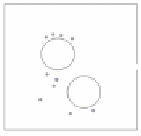Information Technology Reference
In-Depth Information
largest speed, while the other people a smaller speed. In the real simulation, we find
out that this method can make the congestion near the exits very visible.
When taking the obstacles into consideration, the simulation should show the peo-
ple's prejudgment behavior when they have to avoid the obstacles, which means the
moving path of a person should be in compliance with the real circumstances. This
requires the simulation should have a direction judging principles for all people.
In our simulation, we set up a constant distance
d
, we forcibly make the speed
component vertical to the obstacle
=
, and the other speed components will not
change when the distance between the person and the obstacle is smaller than
d
. In
this way, the simulation can guarantee the people move in the “tangential direction”
of the obstacle. Figure 1 shows the specific process of a person avoiding an obstacle:
v
0
The initial
distribution of the
people
People choose their
path at the
beginning
The process of
avoiding an
obstacle
Run away from
the exits
Fig. 1.
The specific process of a person avoiding an obstacle
When there is more than one exit in the area, choosing the suitable obstacle is im-
portant for the people. The classical models always make people run to the nearest
exit without considering the congestion near that exit. This method doesn't take the
people's psychology of avoiding running to the crowed people into consideration and
the simulation can't totally represent the real circumstance.
In the real case, the people will always choose their escaping path based on the dis-
tance to the exits and the congestion extent near the exit. Thus, we introduce the exit
attraction function
i
f
:
kSS
(
−
)
k l
(
−
l
)
f
=
e
⋅
e
1
i
2
max
i
i
Where to one person,
S
represents the total amount of people in his sight.
S
repre-
th
i
l
sents the real amount of the people between this person to the
exit.
represents
max
l
repre-
the largest distance among all the distances between the exits and the person.
th
i
exit and the person. We choose the exit with
the largest
f
to be the person's escaping exit. Figure 2 show the circumstances of
people's choosing different exits:
sents the real distance between the












Search WWH ::

Custom Search